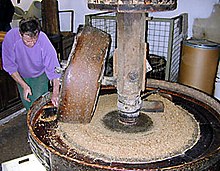Pan mill
The pan mill is a grinder for crushing and mixing stones , ores , paper raw materials or food. One or two upright heavy discs, the so-called runners, rotate around a vertical axis on a base plate and grind the contents. Pan grinders are suitable for grinding sticky, wet, moist or dry materials.
description
The runner and base plate of the pan mill are often made of stone, otherwise, for example, also made of chilled cast iron . Scrapers or baffles are used to distribute the ground material and to transport it to a drain above which a sieve is attached, the size of which can be used to influence the grinding degree of the ground material flowing out. It is not necessarily the case that the grinding table is stationary and the runners rotate in a circle, but there are also models in which the runners are fixed and the trough rotates.
The force that acts on the grist is not only the weight of the runners, but there is also an additional force due to their tendency to precession , see curve top . If the runners are to roll smoothly on the base plate, they must be cones , the tips of which meet in the vertical axis. If this is not wanted, the cones are made flatter or the cone tips point outwards. This creates a relative movement between the rotor and the base plate when rolling, so that the ground material is not only crushed, but also ground.
A pan mill usually works intermittently , i.e. the ground material is put into the empty pan mill , ground and then removed when the rotors are stationary before the machine can be loaded again. Due to this discontinuous procedure, the pan mill was replaced over time by the continuously operating roller mill . In some processes, however, the pan mill allows a continuous process and is therefore still state of the art, for example in pelleting presses .
- In the production of chocolate , pan mills , also referred to here as melangeurs , were among the earliest machines used industrially. They had runners and bottom plates of granite or iron kg, capacity of 100-500, were heated and the preparation of the chocolate mass served by mixing and at least coarse grinding of the basic components, mainly cocoa nibs , cocoa butter , sugar and milk chocolate also dairy products such as milk powder . Due to the crushing effect, the melangeur can also process broken cocoa kernels and granulated sugar, in contrast to other mixing devices that only tolerate cocoa mass and powdered sugar that have already been ground . Because of their low capacity, their high energy requirements and the complex operation, melangeurs in the chocolate industry have been pushed back by other mixing devices.
- In the old oil mills, the pan mill squeezed nuts to produce vegetable oils for oil lamps and dishes. In the oil mills, the runner and base plate are made of monolithic granite.
- In historical paper mills , the fibers were loosened with a pan mill . Even in the industrial era, pan mills were initially used in paper production to defiber waste paper or wood pulp or pulp boards. Today a pulper is mostly used here .
The pan mill is rarely found in modern production facilities because large, expensive stones are required. In the pan mill, there is also a tendency that part of the ground material is thrown away. Therefore, roller mills are mostly used today. The only pan mill still in operation in Switzerland is at Sax-Farben in Urdorf .
In ceramics production you can still find pan mills, especially for building ceramics. In the brick production , pan rollers with a weight of 25 tons are used. In cement production, roller mills are used for grinding the raw material (limestone), which represent a kinematic reversal of the pan grinder: the plate, the so-called grinding table, rotates on top of a gear unit under the grinding rollers, some of which can weigh up to 80 tons ( as a pair of rollers with inner and outer rollers) and also hydraulically pressed with another 200 tons. These pan mill reversals are operated continuously: the raw material is continuously fed into the center of the grinding table; Sufficiently finely ground material (raw meal for the kiln process) is conveyed up by a draft using an air classifier .
See also
Individual evidence
- ^ Walter Wittenberger: Chemical industrial engineering. A help book for chemical technicians and the specialists of the chemical company . 2nd, completely revised edition. Springer, Vienna 1962, ISBN 978-3-7091-3436-8 , p. 154 ( limited preview in Google Book search).
- ^ Heinrich Fincke : Handbook of cocoa products . Ed .: Albrecht Fincke. 2nd Edition. 1965, p. 201 .
- ↑ Kollergang shreds waste paper Historical film recording, around 1935 (0:32 min.)


